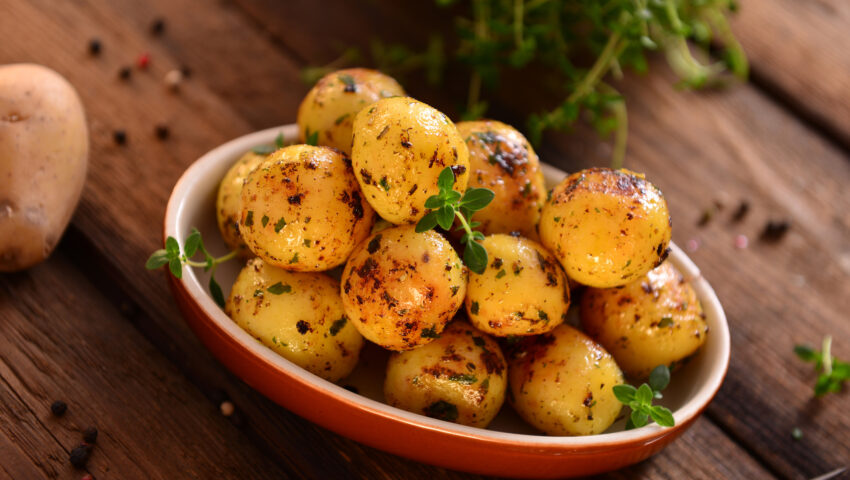Blogs
Winter Vitality – for the love of potatoes

We’ve just left behind September, the harvest month, full of a huge variety of seasonal fruit and vegetables. As we move into winter it can often feel like there is little choice when it comes to eating seasonably. It’s important to maintain variety throughout the seasons to make sure you’re getting a good balance of nutrients all year round.
Potatoes
During winter, warmer, denser meals fill up menus. In the UK we love potatoes, and eat a lot of them. Nutritionally speaking, it often seems that potatoes have gained a bad reputation, as they don’t count as one of your five a day, and it’s often assumed that they serve little purpose other than an energy dense, starchy carbohydrate.
Carbohydrates are currently top of the list of macronutrients we love to hate. They are plagued with controversy, and often subject to confusion.
It’s important to remember that carbohydrates do have many beneficial properties, regardless of what the papers say. They are a major source of energy, and a diverse group that includes sugars, starches, wholegrains and fibre.
Although potatoes don’t count as one of your five a day, they do contain a smattering of micronutrients, which can be a useful contribution to our daily intake. Baked potatoes are a source of potassium and thiamine, potassium is important for the maintenance of blood pressure, while thiamine is important in energy-release from foods. In addition, potatoes also contain fibre, the majority of which is found in the skin. Fibre is important for many reasons, the consumption of which has been linked to many positive health outcomes (1).
Technically speaking, potatoes are root vegetables, however due to their carbohydrate content they are considered a starchy carbohydrate, like rice, pasta or bread. Starches are derived from plant sources and are very much a staple of the British diet. Current dietary guidelines suggest that starchy carbohydrates should take up around a third of our plate over the course of a day, choosing wholegrain or higher fibre options where possible (2).
Starch is classed as a polysaccharide, meaning it is composed of a number of smaller units, known as monosaccharides, linked together. These starches are digested by enzymes in the body, yielding glucose which is then absorbed into the blood stream. Interestingly, the cooking and subsequent cooling of potatoes influences the structure of starch that it contains. Cooked, and cooled potatoes contain resistant starch, which is not absorbed in the small intestine, and is subsequently classified as a type of dietary fibre. There’s increasing research on the effects of resistant starched on colonic health (3) (4). For example, you’ll find this type of resistant starch in the potatoes you’ve cooked and cooled for potato salads.
Winter Vegetable Heroes
In addition to potatoes, the season brings about a large variety of root vegetables. Root vegetables are grown underground, and can be harvested and stored for long periods of time. Choosing a favourite root veg is difficult, so here is a small list of some of my favourite autumnal veg heroes.
-
Beetroot
You’ll find beetroot in a range of different colours, shapes and sizes. The predominate variety which give a purple colour is found in most supermarkets. In terms of its nutritional value, beetroot is a source of potassium and high in manganese. Additionally, one of the main micronutrients present in beetroot is folate. Folate refers to a family of B-group vitamins, including naturally occurring folates found in food, as well as folic acid – a synthetic form used in supplements and food fortification. Folate has a variety of very important functions in the body. It is required for cell division and maintenance, blood formation and immune system functioning and works together with a handful of other vitamins; vitamin B12, B6 and B2.
-
Celeriac
Celeriac is a commonly underrated root vegetable with a slightly nutty flavour that can be used in a similar way to potatoes. Whole roasted, it also makes for an excellent veggie centrepiece. Interestingly, celeriac is a source of four nutrients; folate, vitamin C, thiamine and potassium. Thiamine is a water-soluble B vitamin which is used as a co-enzyme in many energy-yielding metabolic pathways. It is also involved in the normal functioning of the nervous system.
-
Swede
Like celeriac, swede can also be used as an alternative to potatoes. Cooked swede is a good source of vitamin C. Vitamin C has a variety of important functions in the body and is well known for being linked to immune system health, but also has important roles in skin and teeth health as well as increasing our ability to absorb iron. This is particularly important for those on a plant-based diet whose main source of iron comes from plant foods. Combining plant sources of iron with vitamin C can increase its bioavailability when eaten, meaning more is absorbed.
-
Sweet Potato
Although traditionally grown and imported from warmer climates, there has been growth in sweet potato growing in the UK (5). Although the majority that are found in the supermarkets are imported, they are a useful alternative to potatoes over the winter months. Unlike regular potatoes, sweet potatoes count as one of your five a day. They can be replaced like for like; roast them, bake them, or mix up your mash. A bright orange, highly versatile root vegetable, sweet potatoes can be treated in a similar way to butternut squash, swede and parsnips. Good news for us is as well as tasting delicious they also contain multiple vitamins. They are a source of vitamin C, potassium and manganese as well as being high in vitamin A and vitamin E. Similar to carrots, sweet potatoes contain beta carotene, some of which is converted into vitamin A in the body. Vitamin A is important for skin and vision health, as well as supporting a healthy functioning immune system. Sweet potatoes are also an excellent source of vitamin C, containing more than double that of a regular potato. In addition, they are a source of manganese, which is used by the body for bone health, as well as protecting cells from oxidative stress.
References
- How to get more fibre into your diet. NHS UK. 2018
Available from:
https://www.nhs.uk/live-well/eat-well/how-to-get-more-fibre-into-your-diet/
- Eatwell Guide. Gov.uk. 2016
Available from:
- Carbohydrates and Health – SACN. The Stationery Office; 2015.
Available from:
- Lockyer S, Nugent A. Health effects of resistant starch. Nutrition Bulletin. 2017;42(1):10-41.
- Hyde D. Sweet potatoes grown in Britain for first time. The Telegraph. 2015
Available from:




